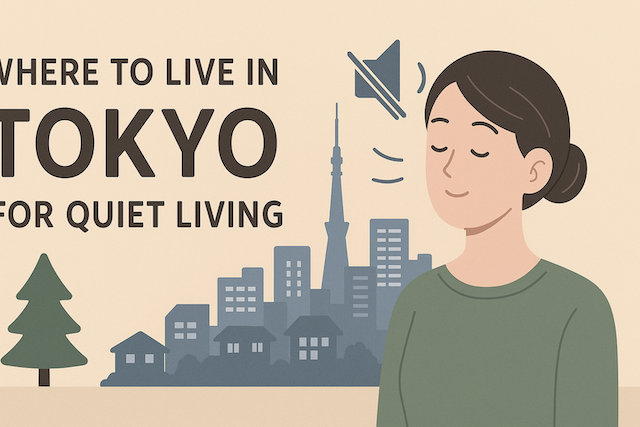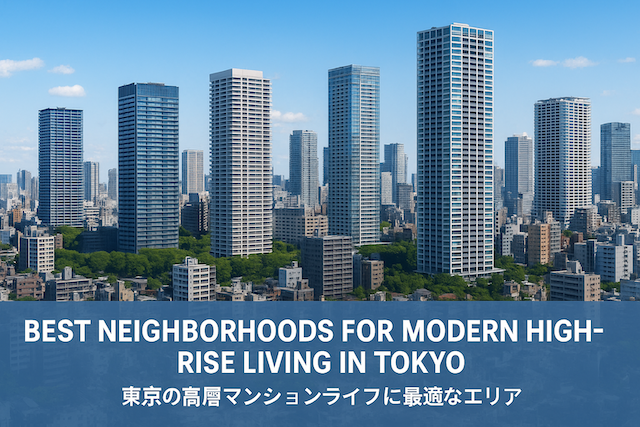Tokyo Neighborhoods with Lowest Utility Costs
Living in Tokyo is a dream for many, but managing daily expenses — especially utility bills — can quickly add up. From electricity and gas to water and internet, the cost of utilities varies depending on the neighborhood, building age, and even the type of accommodation. Fortunately, some areas in Tokyo are known for lower monthly utility expenses, making them great options for budget-conscious residents.
This guide explores Tokyo neighborhoods with the lowest utility costs, breaking down the reasons why they’re more affordable and what kind of lifestyle you can expect in each area.
Overview of Utility Costs in Tokyo
Before diving into neighborhoods, it’s important to understand what “utility costs” mean in Tokyo. Typically, utilities include:
-
Electricity – Varies by provider and usage, especially depending on air conditioning and heating.
-
Gas – Often higher in winter for heating and water.
-
Water and sewage – Billed bi-monthly and consistent across wards.
-
Internet and mobile – Optional but essential for most households.
On average, a single person in Tokyo spends about ¥10,000–¥15,000 per month on utilities, while a small family might pay ¥20,000–¥25,000. However, neighborhoods with newer infrastructure or smaller apartments can significantly lower these costs.
Why Some Neighborhoods Have Lower Utility Costs
Several factors influence utility expenses in different parts of Tokyo:
-
Building Efficiency: Newer apartments with better insulation and LED lighting consume less energy.
-
Availability of City Gas: Areas with “city gas” are cheaper than those relying on LPG (propane).
-
Competition Among Providers: Densely populated areas often have more energy suppliers offering discounts.
-
Size and Layout of Apartments: Compact units are easier and cheaper to heat or cool.
-
Lifestyle Trends: Some districts cater to single professionals or students who use utilities less intensively.
1. Kitasenju (Adachi Ward)
Average Utility Cost: ¥9,000–¥12,000 per month for single residents
Kitasenju is one of the most affordable major hubs in Tokyo, known for its mix of traditional charm and convenient city access. Apartments here tend to be smaller and built with efficiency in mind.
Why it’s cheap:
-
Many newer apartments use city gas, not LPG.
-
The compact layouts reduce heating and cooling costs.
-
Local rental prices are low, and landlords often include partial utilities.
Lifestyle:
Kitasenju offers a balance between affordability and convenience. It has great train access (JR Joban, Chiyoda, Hibiya, and Tsukuba Express lines) and a wide range of supermarkets and restaurants catering to budget-conscious residents.
2. Kamata (Ota Ward)
Average Utility Cost: ¥10,000–¥13,000
Kamata is a southern Tokyo district close to Haneda Airport and known for being family-friendly and affordable.
Why it’s cheap:
-
Older apartment buildings tend to have lower rents, leaving more budget for utilities.
-
The area offers many apartments using city gas.
-
Utility competition is strong due to population density.
Lifestyle:
Kamata combines old-school Tokyo with convenience. The area has shopping streets, public baths (sento), and plenty of inexpensive dining options. It’s ideal for residents who prioritize value and community.
3. Nishikasai (Edogawa Ward)
Average Utility Cost: ¥9,000–¥11,000
Nishikasai is located near the Tokyo Metro Tozai Line, offering direct access to central Tokyo but with much lower living expenses.
Why it’s cheap:
-
Newer developments are energy-efficient.
-
Compact apartments with strong insulation.
-
Competitive internet and electricity providers due to large residential density.
Lifestyle:
Known for its multicultural community and family-oriented vibe, Nishikasai is particularly popular among young professionals and foreign residents. The area’s flat terrain and bike-friendly streets also make commuting easy.
4. Nakano (Nakano Ward)
Average Utility Cost: ¥10,000–¥12,000
Nakano offers a central location just west of Shinjuku, yet utility and rental costs remain reasonable.
Why it’s cheap:
-
Smaller one-room units are common, reducing energy use.
-
City gas is widely available.
-
Many buildings were recently renovated with modern energy systems.
Lifestyle:
Nakano is lively, creative, and student-friendly thanks to its proximity to universities. The area around Nakano Broadway offers entertainment, dining, and shopping options, while quieter residential streets provide a cozy atmosphere.
5. Ikebukuro (Toshima Ward)
Average Utility Cost: ¥11,000–¥13,000
While Ikebukuro is a major business and entertainment district, it still offers pockets of affordability. Smaller apartments, particularly north and west of the main station, tend to have low utility bills.
Why it’s cheap:
-
Efficient newer buildings near universities and share houses.
-
Abundant options for internet and gas providers.
-
Reduced costs due to small unit sizes.
Lifestyle:
Ikebukuro attracts young professionals and students who prefer convenience. It’s one of Tokyo’s most connected hubs, with endless shops, cafes, and nightlife spots — yet surprisingly budget-friendly for small households.
6. Koiwa (Edogawa Ward)
Average Utility Cost: ¥9,000–¥11,000
Koiwa, located along the JR Sobu Line, is known for low rent and overall living expenses.
Why it’s cheap:
-
Predominantly residential with low electricity and water rates.
-
Many compact apartments ideal for singles.
-
Wide use of city gas keeps monthly costs stable.
Lifestyle:
Koiwa offers a quiet, local feel with plenty of small eateries and shopping arcades. While not as glamorous as central Tokyo, it provides excellent value for residents prioritizing savings.
7. Nerima Ward
Average Utility Cost: ¥10,000–¥12,000
Nerima is a large suburban area in western Tokyo, offering affordable family housing and modern apartments.
Why it’s cheap:
-
Newer housing developments use eco-friendly systems.
-
Spacious layouts with excellent insulation.
-
Good access to affordable utilities through city partnerships.
Lifestyle:
Nerima is peaceful and green, ideal for families who want a suburban feel with city access. Despite being residential, it’s well-connected by multiple train lines, including the Seibu Ikebukuro and Oedo lines.
8. Hachioji (Western Tokyo)
Average Utility Cost: ¥8,000–¥10,000
For those willing to live farther from the city center, Hachioji offers some of the lowest overall living and utility costs in the Tokyo metropolitan area.
Why it’s cheap:
-
Apartments and houses are larger but better insulated.
-
Abundant use of energy-saving appliances.
-
Local providers offer cheaper water and gas plans.
Lifestyle:
Hachioji provides a calm suburban environment surrounded by nature. It’s popular among students (due to several universities) and families who prefer a slower pace of life while still commuting to Tokyo.
9. Akabane (Kita Ward)
Average Utility Cost: ¥10,000–¥12,000
Akabane sits at the northern edge of Tokyo but offers quick access to central districts.
Why it’s cheap:
-
High concentration of small apartments and shared housing.
-
Competitive gas and electricity markets.
-
Many energy-efficient renovations in recent years.
Lifestyle:
Akabane combines affordable city living with strong transportation links. It’s lively near the station but has peaceful residential zones just a few blocks away.
10. Tachikawa (Western Tokyo)
Average Utility Cost: ¥9,000–¥11,000
Tachikawa, one of Tokyo’s growing urban centers, provides affordability and comfort.
Why it’s cheap:
-
Excellent modern infrastructure with efficient power systems.
-
City gas coverage and renewable energy options.
-
Lower property management fees compared to central wards.
Lifestyle:
Tachikawa feels like a mini-city with shopping malls, green parks, and direct access to Shinjuku via JR Chuo Line. It’s ideal for those wanting balance between convenience and lower utility bills.
Tips for Reducing Utility Costs Anywhere in Tokyo
Even if you live in a pricier district, you can still save on utilities:
-
Switch electricity providers: Compare plans through sites like “Enechange” to get lower rates.
-
Use city gas: If possible, choose apartments with city gas connections.
-
Opt for smaller units: A 1K or 1DK layout consumes less energy.
-
Monitor air conditioning use: Set AC to 28°C in summer and 20°C in winter to save electricity.
-
Use LED lights and smart plugs: Energy-efficient devices make a big difference.
Final Thoughts
Living in Tokyo doesn’t have to mean high monthly bills. By choosing neighborhoods like Kitasenju, Nishikasai, Koiwa, or Hachioji, you can enjoy comfortable urban living while keeping utility costs under control.
Each of these areas offers a slightly different lifestyle — from the vibrant atmosphere of Ikebukuro to the relaxed, residential feel of Nerima — but all share one thing in common: affordability through efficiency.
Whether you’re a student, professional, or family, choosing the right neighborhood can save you thousands of yen every month while still letting you enjoy everything Tokyo has to offer.
FAQs
What counts as “utility costs” in Tokyo?
In Tokyo, utility costs typically include electricity, gas (city gas or LPG), water and sewage, and home internet. Some rentals add optional services like garbage fees, CATV, or building-wide Wi-Fi. Mobile phone plans are not utilities but should be budgeted separately. For most single renters, utilities average between ¥10,000–¥15,000 per month, while small households often spend ¥20,000–¥25,000 depending on usage and season.
Which neighborhoods are known for lower utility costs?
Areas with a strong stock of compact, energy-efficient apartments and widespread city gas connections tend to be cheapest. Examples include Kitasenju (Adachi), Nishikasai and Koiwa (Edogawa), Akabane (Kita), and parts of Nakano and Ikebukuro. Farther west, Hachioji and Tachikawa also offer low overall utility outlays thanks to modern infrastructure and competitive providers, especially in newer developments near stations.
Why does city gas matter compared to LPG?
City gas is piped and priced under competitive urban rates, while LPG (propane) is delivered in tanks and often costs more per unit. Apartments connected to city gas usually see lower monthly bills for cooking and hot water. If you frequently shower, cook at home, or use a gas heater, choosing a building with city gas can reduce your winter expenses substantially compared to similar units using LPG.
Does newer construction always mean cheaper utilities?
Not always, but often. Newer or renovated buildings usually have better insulation, double-glazed windows, LED lighting, and efficient HVAC systems that lower electricity usage. However, larger floor plans or high ceilings can offset those gains. When comparing properties, consider both the building’s efficiency features and the unit’s size and layout; a compact older unit may still beat a large new one on monthly costs.
How much do seasons affect electricity and gas bills?
Seasonality is significant. In summer, air conditioning drives electricity bills up; in winter, gas use spikes for hot water and heating. Expect higher bills in August and January–February. To control peaks, use programmable AC, seal window gaps, clean filters, take shorter showers, and consider room zoning (cool or heat only the spaces you actively use). Even small behavioral tweaks can trim 10–20% off seasonal highs.
Are water and sewage charges different by ward?
Rates are set by local utilities and change infrequently, so differences across central Tokyo wards are relatively small. Your monthly water bill depends more on household size and habits (showers, laundry frequency, dishwashing) than geography. Buildings with shared industrial washers may reduce in-unit water use, while families or roommates naturally consume more. Check whether your building splits water costs per meter or by headcount.
What apartment features help keep utilities low?
Look for: city gas; inverter AC units; induction cooktops; LED lighting; south or southeast exposure (more winter sun); decent insulation and airtight windows; bathroom dryers with timer modes; and individual meters for electricity, gas, and water. Smart plugs and a modern fridge also help. Avoid units with persistent drafts, west-facing single-pane windows, or aging AC systems that cycle inefficiently.
How do internet costs vary by neighborhood?
Internet pricing is more provider- and building-specific than neighborhood-specific. Dense, popular rental areas often have multiple fiber options and promotional rates. Some buildings include bulk fiber in the common charges; others allow discounted sign-ups when you move in. If low utilities are a priority, ask the agent for buildings with included or building-level fiber (shared plan) to reduce your personal monthly bill.
Is share housing cheaper for utilities than solo renting?
Usually, yes. Many share houses bundle electricity, gas, water, and Wi-Fi into a flat monthly fee. Because residents split costs and spaces are efficiently managed, your effective utility spend is often lower than a studio’s separate contracts. The trade-offs are privacy and control over temperature or appliance use. If predictability matters, a fixed-fee share house can eliminate seasonal bill surprises.
Can I really save by choosing a smaller layout?
Absolutely. A 1R/1K typically costs less to heat and cool than a 1DK or 1LDK. With fewer cubic meters of air and fewer light fixtures, month-to-month usage drops. If you work mostly outside the home or embrace minimalist living, the savings can be meaningful. Combine a compact layout with an energy-efficient building and city gas to push utilities toward the lower end of Tokyo norms.
What everyday habits reduce utility costs the most?
Set the AC to moderate targets (around 28°C in summer, 20°C in winter), use fans to circulate air, shorten showers, run laundry on off-peak times if your plan allows, switch to LED bulbs, unplug idle devices, and use the microwave or induction cooktop instead of long oven sessions. Dry clothes with the bathroom dryer’s timer rather than max heat. Track usage with provider apps to catch spikes early.
How should I compare providers and plans after moving?
When you receive your first one or two bills, record kWh (electricity) and m³ (gas) usage along with dates. Then compare plans by unit price, base fee, and possible time-of-use or loyalty discounts. Consider bundling electricity and gas or adding internet for extra promotions. Revisit annually—usage patterns change with seasons and lifestyle, and a quick check can reveal easy savings without moving neighborhoods.




![Where to Live in Tokyo for Students [2025–2026 Guide]](https://tokyorelocationguide.com/wp-content/uploads/2025/10/ChatGPT-Image-Oct-17-2025-04_32_25-PM.png)


